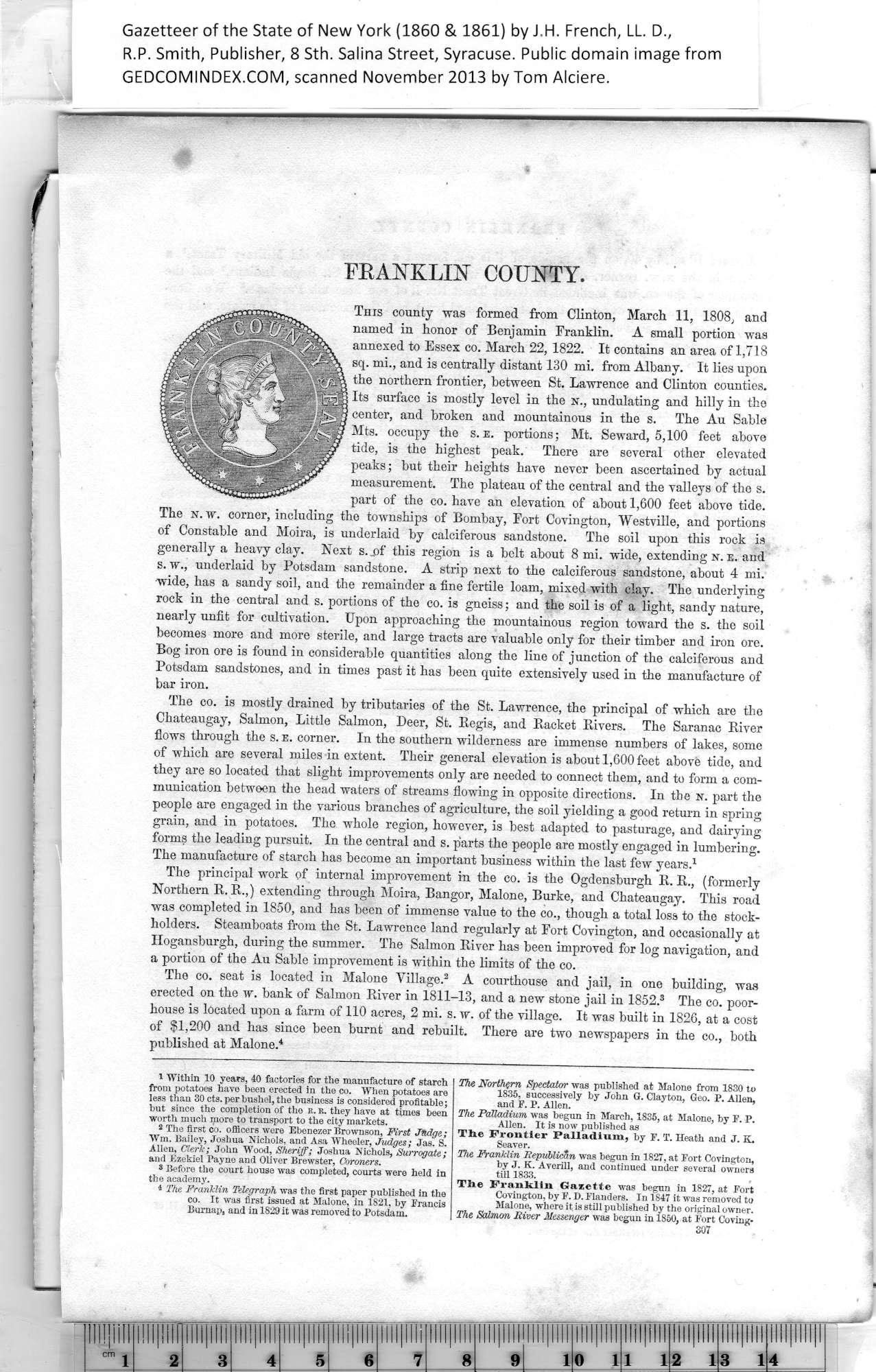|
FBANKLIN COUNTY.
This county was formed from Clinton, March 11, 1808, and
named in honor of Benjamin Franklin. A small portion was
annexed to Essex co. March 22, 1822. It contains an area of 1,718
sq. mi., and is centrally distant 130 mi. from Albany. It lies upon
the northern frontier, between St. Lawrence and Clinton counties.
Its surface is mostly level in the n., undulating and hilly in the
center, and broken and mountainous in the s. The Au Sable
Mts. occupy the s.e. portions; Mt. Seward, 5,100 feet above
tide, is the highest peak. There are several other elevated
peaks; but their heights have never been ascertained by actual
measurement. The plateau of the central and the valleys of the s.
part of the co. have an elevation of about 1,600 feet above tide.
The n. w. corner, including the townships of Bombay, Fort Covington, Westville, and portions
of Constable and Moira, is underlaid by calciferous sandstone. The soil upon this rock is
generally a heavy clay. Next s. .of this region is a belt about 8 mi. wide, extending n. e. and
s. w., underlaid by Potsdam sandstone. A strip next to the calciferous sandstone, about 4 mi.
wide, has a sandy soil, and the remainder a fine fertile loam, mixed with clay. The underlying
rock in the central and s. portions of the co. is gneiss; and the soil is of a light, sandy nature,
nearly unfit for cultivation. Upon approaching the mountainous region toward the s. the soil
becomes more and more sterile, and large tracts are valuable only for their timber and iron ore.
Bog iron ore is found in considerable quantities along the line of junction of the calciferous and
Potsdam sandstones, and in times past it has been quite extensively used in the manufacture of
bar iron.
The co. is mostly drained by tributaries of the St. Lawrence, the principal of which are the
Chateaugay, Salmon, Little Salmon, Deer, St. Kegis, and Backet Kivers. The Saranac Biver
flows through the s. e. corner. In the southern wilderness are immense numbers of lakes, some
of which are several miles in extent. Their general elevation is about 1,600 feet above tide, and
they are so located that slight improvements only are needed to connect them, and to form a com¬
munication between the head waters of streams flowing in opposite directions. In the n. part the
people are engaged in the various branches of agriculture, the soil yielding a good return in spring
grain, and in potatoes. The whole region, however, is best adapted to pasturage, and dairying
forms the leading pursuit. In the central and s. parts the people are mostly engaged in lumbering.
The manufacture of starch has become an important business within the last few years.1
The principal work of internal improvement in the co. is the Ogdensburgh B. B., (formerly
Northern B. B.,) extending through Moira, Bangor, Malone, Burke, and Chateaugay. This road
was completed in 1850, and has been of immense value to the co., though a total loss to the stock¬
holders. Steamboats from the St. Lawrence land regularly at Fort Covington, and occasionally at
Hogansburgh, during the summer. The Salmon Biver has been improved for log navigation, and
a portion of the Au Sable improvement is within the limits of the co.
The co. seat is located in Malone Village.2 A courthouse and jail, in one building, was
erected on the w. bank of Salmon Biver in 1811-13, and a new stone jail in 1852.3 The co. poor¬
house is located upon a farm of 110 acres, 2 mi. s. w. of the village. It was built in 1826, at a cost
of $1,200 and has since been burnt and rebuilt. There are two newspapers in the co., both
published at Malone.4
|
The Northern Spectator was published at Malone from 1830 to
1835, successively by John G. Clayton, Geo. P. Allen,
and P. P. Allen.
The Palladium was begun in March, 1835, at Malone, by E. P.
Allen. It is now published as
The Frontier Palladium, by F. T. Heath and J. K.
Seaver.
The Franklin Republican was begun in 1827, at Fort Covington,
by J. K. Averill, and continued under several owners
till 1833.
The Franklin Gazette was begun in 1827, at Fort
Covington, by F. D. Flanders. In 1847 it was removed to
Malone, where it is still published by the original owner.
The Salmon River Messenger was begun in 1850, at Fort Coving- |
307
1
Within 10 years, 40 factories for the manufacture of starch
from potatoes have been erected in the co. When potatoes are
less than 30 cts. per bushel, the business is considered profitable;
hut since the completion of the r. r. they have at times been
worth much more to transport to the city markets.
2
The first co. officers were Ebenezer Brownson, First Judge;
Wm. Bailey, Joshua Nichols, and Asa Wheeler, Judges; Jas. S.
Allen, Clerk; John Wood, Sheriff; Joshua Nichols, Surrogate;
and Ezekiel Payne and Oliver Brewster, Coroners.
3
8 Before the court house was completed, courts were held in
the academy.
4
* The Franklin Telegraph was the first paper published in the
co. It was first issued at Malone, in 1821, by Francis
Burnap, and in 1829 it was removed to Potsdam.
|
